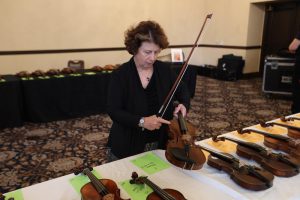Guest Column: SF Symphony’s Barbara Bogatin on music and hope

Czech composer Hans Krása, courtesy Wikipedia Commons.
The string trio we played was born of suffering, written in turbulent times. The man who wrote it had just lost his home and was forced to live in crowded, unsafe conditions while witnessing people around him become ill and die as the world he knew crumbled. Like most musicians and performing artists, he had lost his job, and with it, his only source of income. He watched in disbelief as strife mounted in his beloved country, and his freedoms were taken away one-by-one.
A reflection of life during a pandemic, California fire season, social justice protests and politics 2020? No, this music was written by the Jewish Czech composer Hans Krása in 1943, in the Terezin Ghetto outside of Prague. My San Francisco Symphony colleagues Raushan Akhmedyarova, Adam Smyla and I performed it at Davies Symphony Hall last February, a few weeks before the world changed and lockdown began. We played on a violin, viola and cello that had been rescued from the Holocaust. Our concert was part of a national celebration of hope through music, which brought 50 rescued and restored Holocaust instruments from the Violins of Hope collection to the Bay Area, where 40 performing arts groups took turns sharing them in concerts, lectures and exhibitions.
Krása called his piece, simply, “Dance,” and he filled it with catchy folk tunes, percussive strumming effects, and sharp pizzicato accents to bring out the jazzy syncopations. What creative well did he mine to find the joie de vivre and ebullient interplay as he stared into the abyss? Was he able to ignore his appalling surroundings, or did they fuel his imagination in the search for an inspiring antidote to despair?

Barbara Bogatin plays instruments from the Violins of Hope exhibit at the War Memorial building in San Francisco in February 2020. Courtesy: SF Symphony.
This complex music took us many hours to get performance‐ready. I had the luxury of playing from newly printed parts, practicing at my leisure over several weeks—with manicured nails and a freshly re-haired bow. Yet I couldn’t help imagining a cold, hungry cellist trying to discern the hastily scrawled musical notation in dim light, his stiff fingers searching out a pattern for the tricky passages, struggling to choose bowings that would render a seamless legato out of his battered, cracked hull of a cello. Where did the ragged fellow find the strength to rehearse with his violinist and violist friends each day?
Since early March, throughout small towns and cobblestone piazzas of Europe, musicians have played nightly concerts on balconies during the toughest days of lockdown.
For much of the spring, summer and early fall in neighborhoods around San Francisco, you could hear string quartets, brass bands, accordion ensembles and bluegrass jams joyfully playing for the smiles of passersby or any neighbors who would pull up a lawn chair. The internet has flourished with musical offerings for every taste, from symphony orchestras playing in unison from their living rooms, to separated gospel choirs praising the heavens together, to freestylers beat-boxing on rooftops, to the joyful noise of the “Covid Cello Project” with hundreds of eager cellists zooming in renditions of Led Zeppelin and the Barber Adagio for Strings.
Knowing the power of music to impact and transform, the San Francisco Symphony undertook an initiative to reach out to communities far afield from our usual audiences, stretching across cultural boundaries and welcoming musicians from the worlds of Chinese and Mexican music, jazz and hip-hop to collaborate. With this series of videos and podcasts called Currents, the intention was to eliminate perceived barriers that often separate different musical genres and their fans.

Barbara Bogatin (in foreground) during filming of San Francisco Symphony’s CURRENTS Episode III: From Scratch, featuring Kev Choice. Courtesy Kim Huynh.
Earlier this fall, I was on stage again at Davies Hall with other symphony string players, masked up and spaced apart, in an unlikely collaboration with hip-hop artist Kev Choice and MC and lyricist AÏMA the DRMR in the latest installment of Currents: From Scratch. With Kev as pianist, we recorded his most recent composition, “Movements,” joining a symphonic term with political actions in the larger world. Kev’s words tell of revolutionaries like Beethoven and Stravinsky, who “used the music as the struggle,” linking them to “John Lewis and his good trouble.” He also rapped about the musical connections we performers feel, where hope shines its incandescent light to reveal that whether conjuring tears of grief or exultation of joy, music finds its way into our soul to deploy long‐buried incantations that reemerge as inspiration.
Hans Krása found hope in his music. I may not know the agonies he suffered, but I do understand the motivation that propelled him against all odds to write music that others could realize in living sound and even more could hear in person, reminding musicians and audiences alike of a better, saner world that will be there for us one day.
